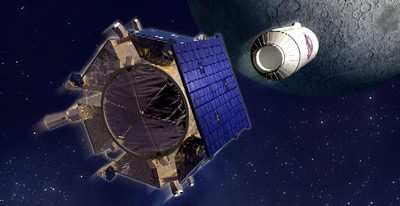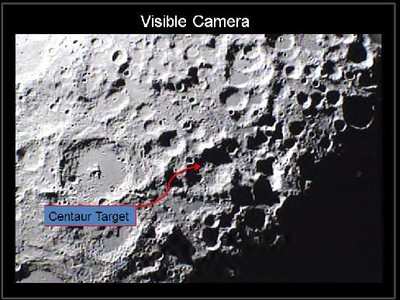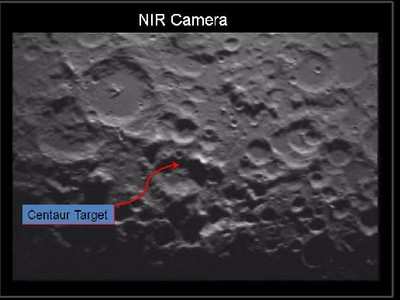LCROSS Impacts Confirm Water In Lunar Crater
 NASA announced Friday
that preliminary data from NASA's Lunar Crater Observation and
Sensing Satellite, or LCROSS, indicates the mission successfully
uncovered water in a permanently shadowed lunar crater. The
discovery opens a new chapter in understanding the moon.
NASA announced Friday
that preliminary data from NASA's Lunar Crater Observation and
Sensing Satellite, or LCROSS, indicates the mission successfully
uncovered water in a permanently shadowed lunar crater. The
discovery opens a new chapter in understanding the moon.
The LCROSS spacecraft and a companion rocket stage made twin
impacts in the Cabeus crater Oct. 9 that created a plume of
material from the bottom of a crater that has not seen sunlight in
billions of years. The plume traveled at a high angle beyond the
rim of Cabeus and into sunlight, while an additional curtain of
debris was ejected more laterally.
"We're unlocking the mysteries of our nearest neighbor and, by
extension, the solar system," said Michael Wargo, chief lunar
scientist at NASA Headquarters in Washington. "The moon harbors
many secrets, and LCROSS has added a new layer to our
understanding."
Scientists long have speculated about the source of significant
quantities of hydrogen that have been observed at the lunar poles.
The LCROSS findings are shedding new light on the question with the
discovery of water, which could be more widespread and in greater
quantity than previously suspected. If the water that was formed or
deposited is billions of years old, these polar cold traps could
hold a key to the history and evolution of the solar system, much
as an ice core sample taken on Earth reveals ancient data. In
addition, water and other compounds represent potential resources
that could sustain future lunar exploration.

Since the impacts, the LCROSS science team has been analyzing
the huge amount of data the spacecraft collected. The team
concentrated on data from the satellite's spectrometers, which
provide the most definitive information about the presence of
water. A spectrometer helps identify the composition of materials
by examining light they emit or absorb.
"We are ecstatic," said Anthony Colaprete, LCROSS project
scientist and principal investigator at NASA's Ames Research Center
in Moffett Field, California. "Multiple lines of evidence show
water was present in both the high angle vapor plume and the ejecta
curtain created by the LCROSS Centaur impact. The concentration and
distribution of water and other substances requires further
analysis, but it is safe to say Cabeus holds water."
The team took the known near-infrared spectral signatures of
water and other materials and compared them to the impact spectra
the LCROSS near infrared spectrometer collected.

"We were able to match the spectra from LCROSS data only when we
inserted the spectra for water," Colaprete said. "No other
reasonable combination of other compounds that we tried matched the
observations. The possibility of contamination from the Centaur
also was ruled out."
Additional confirmation came from an emission in the ultraviolet
spectrum that was attributed to hydroxyl, one product from the
break-up of water by sunlight. When atoms and molecules are
excited, they release energy at specific wavelengths that can be
detected by the spectrometers. A similar process is used in neon
signs. When electrified, a specific gas will produce a distinct
color. Just after impact, the LCROSS ultraviolet visible
spectrometer detected hydroxyl signatures that are consistent with
a water vapor cloud in sunlight.

Data from the other LCROSS instruments are being analyzed for
additional clues about the state and distribution of the material
at the impact site. The LCROSS science team and colleagues are
poring over the data to understand the entire impact event, from
flash to crater. The goal is to understand the distribution of all
materials within the soil at the impact site.
"The full understanding of the LCROSS data may take some time.
The data is that rich," Colaprete said. "Along with the water in
Cabeus, there are hints of other intriguing substances. The
permanently shadowed regions of the moon are truly cold traps,
collecting and preserving material over billions of years."
LCROSS was launched June 18 from NASA's Kennedy Space Center in
Florida as a companion mission to the Lunar Reconnaissance Orbiter,
or LRO. Moving at a speed of more than 1.5 miles per second, the
spent upper stage of its launch vehicle hit the lunar surface
shortly after 4:31 a.m. PDT Oct. 9, creating an impact that
instruments aboard LCROSS observed for approximately four minutes.
LCROSS then impacted the surface at approximately 4:36 a.m.
LRO observed the impact and continues to pass over the site to
give the LCROSS team additional insight into the mechanics of the
impact and its resulting craters. The LCROSS science team is
working closely with scientists from LRO and other observatories
that viewed the impact to analyze and understand the full scope of
the LCROSS data.
 ANN's Daily Aero-Term (04.24.24): Runway Lead-in Light System
ANN's Daily Aero-Term (04.24.24): Runway Lead-in Light System ANN's Daily Aero-Linx (04.24.24)
ANN's Daily Aero-Linx (04.24.24) Aero-FAQ: Dave Juwel's Aviation Marketing Stories -- ITBOA BNITBOB
Aero-FAQ: Dave Juwel's Aviation Marketing Stories -- ITBOA BNITBOB Classic Aero-TV: Best Seat in The House -- 'Inside' The AeroShell Aerobatic Team
Classic Aero-TV: Best Seat in The House -- 'Inside' The AeroShell Aerobatic Team Airborne Affordable Flyers 04.18.24: CarbonCub UL, Fisher, Affordable Flyer Expo
Airborne Affordable Flyers 04.18.24: CarbonCub UL, Fisher, Affordable Flyer Expo






